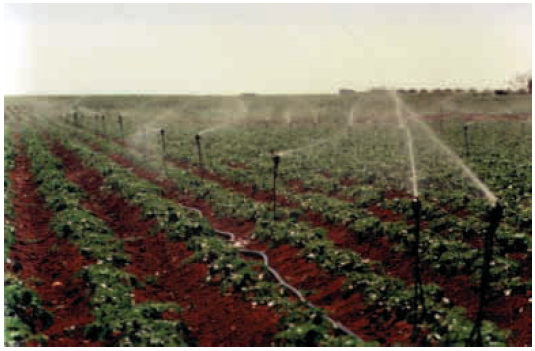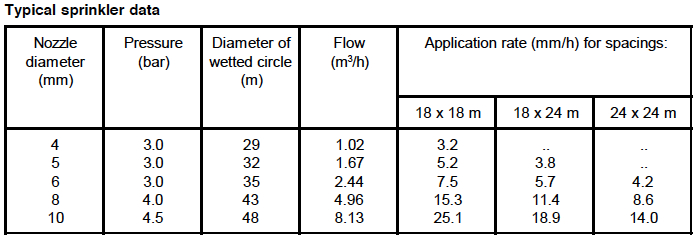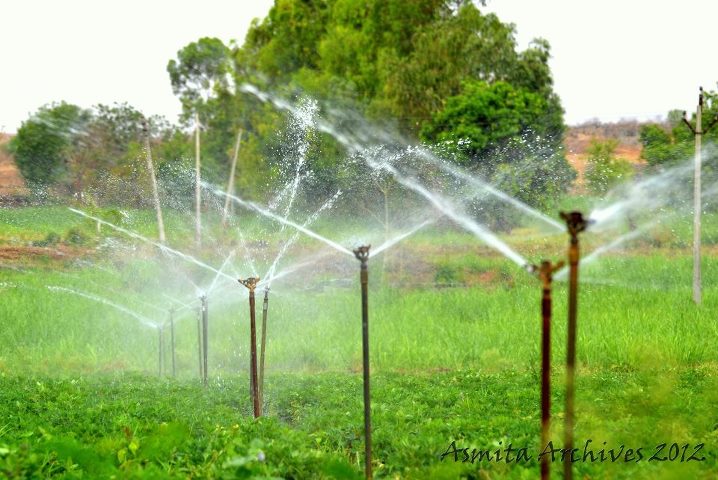Sprinkler
Sprinkler irrigation involves distributing water in pipes under pressure and spraying it into the air so that it breaks up into small droplets and falls to the ground like natural rainfall. Sprinkler systems are generally more efficient and use less labour than surface irrigation and can be adapted more easily to sandy and erodible soils on undulating ground. There are many types of sprinkler system available, but the most common is a system using portable pipes (aluminium or plastic) supplying rotary impact sprinklers. An individual rotary impact sprinkler produces a circular wetting pattern with poor uniformity. To obtain good uniformity, several sprinklers are always operated close together so that the patterns overlap.
The main performance characteristics of the sprinklers used in hose-move systems are:
- two nozzles: 3.0-6.0 mm (range) x 2.5-4.2 mm (spreader);
- low to medium operating pressure: 1.8-3.5 bars;
- water discharge: 1.1- 3.0 m_/h;
- diameter coverage (wetted): 18-35 m;
- jet angle: 20¡-30¡ (except where low angle jet is needed, e.g. strong wind, treated water);
- type of connection: threaded internal or external _-1 in.
Contents
Suitable conditions
Traditional sprinkler irrigation is not so well suited to small farms. Typical spacings for sprinklers are 18 m × 18 m, and so they are not so flexible and adaptable to the multitude of small plots usually found on many farms. An alternative which may be more applicable to small farms is the use of smaller sprinklers connected to the mainline by flexible hoses. This is often called a hose-pull system. These sprinklers have great flexibility in operation and are easily re-located around the farm.
| Advantages | Disadvantages |
|---|---|
| - High irrigation application efficiency - 75 percent. - Easy design, simple installation and operation. |
- Moving the hoses with the sprinklers is heavy and unpleasant work. - Long duration for the irrigation cycle. |
Construction, operations and maintenance

Pressure is an important factor in successful sprinkler operation. Typical operating pressures range from 2 to 6 bar, and so energy requirements can be much greater than for surface irrigation. If sprinklers are working at the pressure recommended by the manufacturer then the distribution will be good. If the pressure is above or below this value then the distribution will be adversely affected. The most common problem is when pressure is too low and this happens when pump and pipes wear, increasing friction and so reducing pressure.

Costs
The total cost for the installation of the system in 2.0 ha (as in the example design, below) is US$1 790.00, or less than US$1 000/ha. A cost analysis shows that the head control costs about US$70. The major cost items are the plastic pipes, PVC and PE tubes, for the system’s network which amount to US$1 177, 65.7 percent of the total cost. Imported sophisticated equipment, such as the sprinklers, rarely exceeds 10 percent of the total cost.
Field experiences
EXAMPLE DESIGN: Hose-move sprinkler for cotton
Area and crop: An area of approximately 2.0 ha planted with cotton at the beginning of August. The field is square and level. Soil, water and climate: Medium texture soil of good structure, with good infiltration and internal drainage. The soil available moisture (Sa) is 110 mm/m depth. The water is of good quality with no salinity or toxicity hazards; the source is a tube-well equipped with a pumping unit delivering 36 m3/h. The peak irrigation demand is in October, at the midseason growth stage of the crop.
Crop water requirements and irrigation scheduling: The pan average readings in October are 5.6 mm/d. This figure multiplied by 0.66 (pan correction factor) gives an ETo of 3.7 mm/d. The crop factor kc for cotton at this stage is taken as 1.05, the root depth 1.0 m and the moisture depletion 50 percent. Then, ETc cotton = 3.7 x 1.05 = 3.88 mm/d. The net application depth is Sa 110 mm x root depth 1.0 m x depletion 0.5 = 55 mm. The maximum permissible irrigation interval in October is 55 mm ÷ 3.88 mm/d = 14 days. The irrigation frequency depends on many factors and in no case should exceed the maximum permissible irrigation interval. The system’s application efficiency is 75 percent, therefore, the gross application depth at peak is: 55 mm ÷ 0.75 = 73.3 mm. The gross irrigation dose is: 73.3 mm x 10 x 2.0 ha = 1 466 m3.
Acknowledgements
- M. Kay and N. Hatcho. Small-scale pumped irrigation energy and costs. FAO. 1992.
- A. Phocaides. TECHNICAL HANDBOOK ON PRESSURIZED IRRIGATION TECHNIQUES. FAO, 2000.
